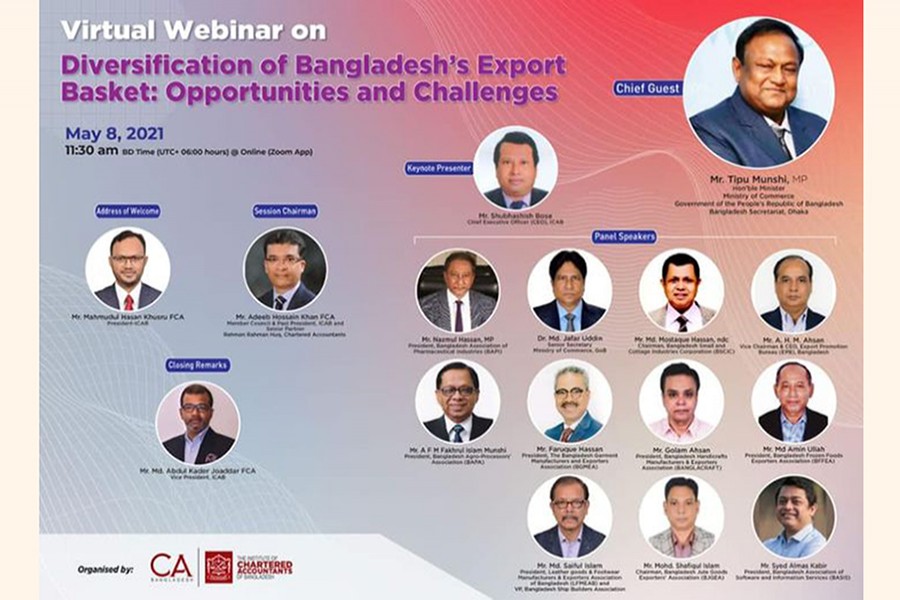
Published :
Updated :

Speakers at a virtual discussion on Saturday stressed the need for exploring untapped markets in the Commonwealth of Independent States (CIS), Latin America and African regions instead of concentrating only on two areas --European Union including the UK, and the USA -- to enhance export of products and services from the country.
They said the African continent accounted for the least market share of exports from Bangladesh while a huge opportunity lay there.
The speakers said that there were fourteen SADC countries in the continent, a common customs union, and a gateway to 290 million people.
If a product enters a member country, it can easily travel to other countries without facing customs problems. So efforts should be made to conclude preferential trade agreements or free trade agreements with African countries.
The observations came at a webinar on 'Diversification of Bangladesh's Export Basket: Opportunities and Challenges' organised by the Institute of Chartered Accountants of Bangladesh (ICAB).
ICAB Council Member and Past President Adeeb H Khan FCA moderated the webinar.
Speaking as the chief guest, Commerce Minister Tipu Munshi said export earnings have crucial effects on the country's investment, GDP growth, real exchange rate, unemployment, government revenue and expenditure.
"Diversification of export is the highest priority area of our government, and in view of that we are providing subsidy to encourage export of a number of products," he said. The government was also implementing 100 new export processing zones (EPZs) for boosting export.
He said the country qualified for graduating from the least developed country (LDC) status to a developing country.
"With this new tag of middle income country, Bangladesh will lose the right to low interest loans and other trade benefits," he said. There was no alternative to export diversification for rapid growth, he added.
He said the Ministry of Commerce was working on making the embassies and foreign missions active to expand the export market of Bangladeshi products.
He further said that the ministry of commerce was trying to make Bangladesh's embassies and foreign missions' activities dynamic and diverse in order to survive in a rapidly changing and competitive world trade system.
The minister said they had undertaken EC4 Projects on leather products, plastics and light engineering worth Tk 10 billion in collaboration with the IFC.
This would help the sectors enhance their capacities for competitiveness, especially in the post-graduation period, he added.
Shubhashish Bose, Chief Executive Officer of ICAB and Former Senior Secretary, presented the keynote paper.
Under the generalised system of preference (GSP) 80 per cent of Bangladeshi products were getting duty-free, access to 27 countries of European Union, Australia, New Zealand, Norway, Switzerland , the UK, the Turkey, Canada and Russia, said keynote speaker Shubhashish Bose.
He said although the geographic location of the country proved ideal for global trade with very convenient access to international sea and air routes, but Bangladesh was facing a negative impression in export-import balance of trade.
"Currently the country is facing trade deficit of US$15000 million."
He listed exportable six major items -- woven garments, knit garments, leather & leather products, jute and jute goods, agricultural products, frozen foods. They constituted 92 per cent of the country's total exports during the fiscal year 2019-20, he said
"IT sector, pharmaceutical products, ocean-going ship building industry, light engineering, ceramic and porcelain ware are thrust sectors and deserve more attention to bag more foreign currency."
ICAB President Mahmudul Hasan Khusru, in his welcome speech, said the country's exports concentrated on RMG products.
"Leveraging Bangladesh's comparative advantage in the area of labour cost, RMG exports grew at an impressive rate which made it unique among low-income countries like Bangladesh, he added."
Saiful Islam said during the pandemic the export of leather goods declined as they were luxurious items and the buyers moved from leather goods to synthetic items.
He said the environmental issues threatened the industry a lot.
"We need to set up a central effluent treatment plant in our tannery area to deal with liquid and solid waste so that the leather products could survive in the competitive market," he said.
He further said, "to achieve the SDG, we have to earn 5 billion USD from the leather goods."
Also present Among others, were Md. Jafar Uddin, Senior Secretary, Ministry of Commerce, ICAB Vice President Maria Howlader FCA, Md. Mostaque Hassan, Chairman, Bangladesh Small and Cottage Industries Corporation (BSCIC), A. H. M. Ahsan, Vice Chairman and CEO of the Export Promotion Bureau (EPB), Bangladesh, A F M Fakhrul Islam Munshi, President, Bangladesh Agro-Processors' Association (BAPA), Faruque Hassan, President of Bangladesh Garment Manufacturers and Exporters Association (BGMEA), Golam Ahsan, President, Bangladesh Handicrafts Manufacturers and Exporters Association (BANGLACRAFT), Md. Saiful Islam, President, Leather goods & Footwear Manufacturers & Exporters Association of Bangladesh (LFMEAB) and Vice President, Bangladesh Ship Builders Association, Mohd. Shafiqul Islam, Chairman, Bangladesh Jute Goods Exporters' Association (BJGEA) and Syed Almas Kabir, President, Bangladesh Association of Software and Information Services (BASIS).


 For all latest news, follow The Financial Express Google News channel.
For all latest news, follow The Financial Express Google News channel.